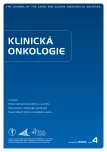Gamma-heavy chain disease
Authors:
P. Kušnierová 1,2; D. Zeman 1,2; T. Jelínek 3; R. Hájek 3
Authors‘ workplace:
Ústav laboratorní dia gnostiky, Oddělení klinické bio chemie, FN Ostrava
1; Katedra bio medicínských oborů, LF OU, Ostrava
2; Hematoonkologická klinika FN a LF OU, Ostrava
3
Published in:
Klin Onkol 2020; 33(4): 282-285
Category:
Original Articles
doi:
https://doi.org/10.14735/amko2020280
Overview
Background: Gamma-heavy chain disease is a rare disease, described so far in approximately 150 cases. The aim of this work was laboratory diagnostics of immunoglobulin heavy chain disease.
Materials and methods: A 60-year-old patient was referred to the University Hospital in Ostrava for suspected marginal zone lymphoma from gastric biopsy. Staging examinations including bone marrow trepanobiopsy and PET/CT were added; special examinations required serum protein electrophoresis, immunofixation electrophoresis, determination of polyclonal immunoglobulins, free light chains, and immunoglobulin heavy/light chain pairs. Isoelectric focusing in agarose gel followed by affinity immunoblotting and SDS electrophoresis was added due to unclear findings. Results: 0.1 % of plasma cells were found in the bone marrow, of which 87 % were clonal (pathological) plasma cells, followed by the cyt cytotype LAMBDA + CD38 + CD138 + CD45 + CD19 + CD56 - CD27 + CD81 - CD117-. Monoclonal heavy chains were found in the patient‘s serum. No monoclonal immunoglobulin heavy or light chains were detected in urine. The PET/CT examination showed generalized lymphadenopathy, splenomegaly and inhomogeneous accumulation of fluorodeoxyglucose in axillary and appendicular skeleton, but without the presence of typical osteolytic lesions.
Conclusion: Monoclonal heavy chains of immunoglobulins are a rare disease. In contrast to the detection of a complete paraprotein molecule, additional methods must be used to confirm them. The finding of monoclonal heavy chain gamma in the serum of the study patient is related to the presence of marginal zone lymphoma, which was proven from a gastric biopsy.
The study was supported by the project of MH CZ – DRO – FNOs /2017 (Biobank in Teaching Hospital Ostrava)
The authors declare they have no potential conflicts of interest concerning drugs, products, or services used in the study.
The Editorial Board declares that the manuscript met the ICMJE recommendation for biomedical papers.
Keywords:
electrophoresis – immunofixation electrophoresis – heavy chain disease – isoelectric focusing – SDS electrophoresis
Sources
1. Kyle RA. The monoclonal gammopathies. Clin Chem 1994; 40 (11): 2154–2161.
2. Seligmann M. Heavy chain disease. In: Multiple myeloma and other paraproteinemias. Edinburgh: Churchill Livingstone 1986 : 263–285.
3. Franklin EC. Structural studies of human 7S gamma-globulin (G immunoglobulin): further observations of a naturally occurring protein related to the crystallizable (fast) fragment. J Exp Med 1964; 120 (1): 691–709. doi: 10.1084/jem.120.5.691.
4. Tsunemine H, Zushi Y, Sasaki M et al. Gamma heavy chain disease (-HCD) as iatrogenic immunodeficiency-associated lymphoproliferative disorder: Possible emergent subtype of rheumatoid arthritis-associated -HCD. J Clin Exp Hematop 2019; 59 (4): 196–201. doi: 10.3960/jslrt.19025.
5. Cook JR, Harris NL, Isaacson PG et al. Heavy chain diseases. In: Swerdlow SH, Campo E, Harris NL et al. WHO classification of tumours of haematopoietic and lymphoid tissues. 4th ed, Lyon, IARC, World Health Organization 2017 : 237–240.
6. Wahner-Roedler DL, Witzig TE, Loehrer LL et al. Gamma-heavy chain disease: review of 23 cases. Medicine (Baltimore) 2003; 82 (4): 236–250. doi: 10.1097/01.md.0000085058.63483.7f.
7. Fermand JP, Brouet JC, Danon F et al. Gamma heavy chain „disease“: heterogeneity of the clinicopathologic features. Report of 16 cases and review of the literature. Medicine (Baltimore) 1989; 68 (6): 321–335.
8. Husby G, Blichfeldt P, Brinch L et al. Chronic arthritis and gamma heavy chain disease: coincidence or pathogenic link? Scand J Rheumatol 1998; 27 (4): 257–264.
9. Zeman D, Kušnierová P, Bojková J et al. Quantitation of IgG kappa and IgG lambda in the cerebrospinal fluid by sandwich ELISA method. J Immunoassay Immunochem 2017; 38 (2): 165–177. doi: 10.1080/15321819.2016. 1233889.
10. Kaleta E, Kyle R, Clark R et al. Analysis of patients with -heavy chain disease by the heavy/light chain and free light chain assays. Clin Chem Lab Med 2014; 52 (5): 665–669. doi: 10.1515/cclm-2013-0714.
11. Deighan WI, O‘Kane MJ, McNicholl FP et al. Multiple myeloma and multiple plasmacytomas associated with free gamma heavy chain, free kappa light chain and IgGk paraproteins: an unusual triple gammopathy. Ann Clin Biochem 2016; 53 (6): 706–711. doi: 10.1177/0004563216646594.
12. Tichý M, Maisnar V, Stuchlík J et al. Nemoc z těžkých řetězců µ. Klin Biochem Metab 2007; 15 (36):
78–81.
13. Zushi Y, Sasaki M, Saitoh T et al. Gamma-heavy chain monoclonal gammopathy with undetermined significance (MGUS). J Clin Exp Hematop 2019; 59 (3): 119–123. doi: 10.3960/jslrt.19008.
14. Thoren KL, Eveillard M, Chan P et al. Identification of gamma heavy chain disease using MALDI-TOF mass spectrometry. Clin Biochem 2020; 77 : 57–61. doi: 10.1016/j.clinbiochem.2019.12.010.
Labels
Paediatric clinical oncology Surgery Clinical oncologyArticle was published in
Clinical Oncology

2020 Issue 4
- Metamizole at a Glance and in Practice – Effective Non-Opioid Analgesic for All Ages
- Possibilities of Using Metamizole in the Treatment of Acute Primary Headaches
- Metamizole in perioperative treatment in children under 14 years – results of a questionnaire survey from practice
- Obstacle Called Vasospasm: Which Solution Is Most Effective in Microsurgery and How to Pharmacologically Assist It?
- Metamizole vs. Tramadol in Postoperative Analgesia
Most read in this issue
- Cervical cancer in pregnancy
- Integrated diagnostics of diffuse gliomas
- Atypical course of typical lung carcinoid
- Gamma-heavy chain disease
